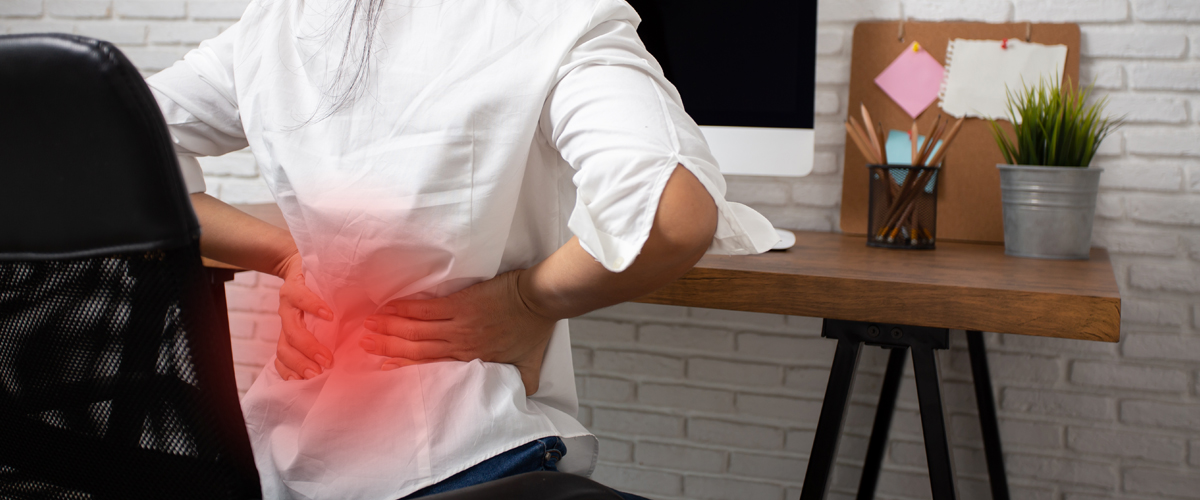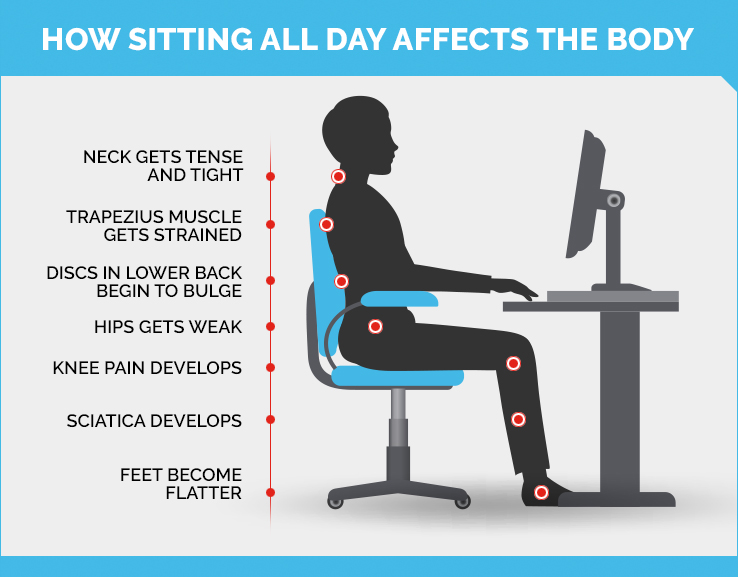Is Too Much Sitting Harming Your Body?
Dr. Elan Goldwaser discusses the dangers of prolonged sitting, how it causes more than just back pain, and ways to undo the damage.

Our bodies were not designed to sit for long periods of time, yet most of us are guilty of sitting too much. Regardless of our age or occupation, we sit — in front of a screen — far more frequently than we should be. While more and more studies confirm the negative effects of a sedentary life, the good news is that people can actively address the wear-and-tear with some simple changes.
Dr. Elan Goldwaser, an osteopathic physician with NewYork-Presbyterian Lawrence Hospital who is a non-operative sports medicine specialist, spoke with Health Matters about how sitting too long can harm our bodies — from our necks, through our backs, and even down to our feet — and discusses steps people can take to stay healthy, high functioning, and pain-free.
What is the impact of sitting all day?
As sitting all day becomes more accepted, we decondition ourselves, and when we’re deconditioned, we end up increasing our risk for injury.
It’s about posture more than anything else. The neck gets tense and tight because we’re straining. This is assuming we don’t have great posture to begin with. We’re arching our necks up a little bit, which increases the curvature of our necks, or cervical lordosis. It puts a strain on our trapezius muscle, which connects to the shoulder and the upper back to hold the neck up in place. Over time that becomes tender, painful, and tight. We begin to develop those classic “knots.”
Then the whole back starts to arch forward because the muscles get a little strained and thus a little weaker. As the back starts coming forward, the body is almost caving in on itself. The lower back bears the brunt of the strain.
What are the most serious problems caused by sitting too much?
One of the bigger problems is that the discs in between our lumbar vertebrae start to bulge, which usually becomes a chronic problem. When a disc bulges or even herniates, the muscles around it start to lock up to hold everything in place so we can’t damage it further. Which is fine if we don’t move, but that’s not what our bodies were made for. We’re made to move, and when we try to stand and move again, we’re asking these tight muscles to comply but they’re not going to. All these awkward stresses on the body are collectively called “biomechanical instability.”

You mentioned that biomechanical instability often begins at the hips and lower back, and that weak hips are “borderline epidemic.”
People will come in — especially kids — and they’ll say, “My ankles hurt a little bit and my knees hurt a little in front, usually after sports.” I ask if they have hip pain and usually they’ll say no. But when we examine them, their hips are not only really weak but there’s often tenderness on the sides of their hips where the gluteus muscles attach.
When you’re sitting, you’re putting all your muscles into a different kind of posture. So you’re stretching some of the hamstring muscles, you’re loosening some of the quadriceps, and you’re creating a different kind of posture for your hips. When you go to stand up, you end up trying to put the pelvis back into a standing position and some of these muscles get irritated and strained in the process. You could even compress nerves and develop common issues like sciatica from sitting too much.
How do weak hips affect the rest of your body?
Think of the hips as the keystone for the body — they have to be strong and sturdy to hold the legs and torso in a good alignment. To maintain good posture, the hips have to battle against gravity. As hips weaken and gravity wins out, the legs collapse inward, putting pressure on your kneecaps and eventually causing the feet to flatten.
If the hips aren’t strong enough, they can’t hold themselves up when we try to take a step. They end up dropping with each step we take, which can lead to hip pain.
To compensate for these poor leg mechanics, the low back starts to take on extra strain as it unnaturally bends against the hip dropping during every step. This eventually causes pain that travels up the spine and into the neck.
We’re twisting our muscles into positions that they don’t normally like to exist in for long periods of time. When that happens, the back starts to slump forward, we develop poor posture, the muscles themselves get a little strained — and that strain becomes weakness.
We start developing back pain because our bodies are evolutionarily not supposed to be seated for long periods of time.

Dr. Elan Goldwaser
Are you seeing any trends in certain types of injuries?
The flat feet, the kneecap pain, and the weak hips — I see those across the entire spectrum of ages and sports.
Sitting doesn’t just affect the bones and muscles. It affects metabolism as well, and as we gain weight, it’s more pressure and increased force that go through the joints and can cause more injury.
You also see decreased blood flow. People end up with more varicose veins. Even blood flow to the brain gets a little dampened and you get “foggy brain,” where you’re a little slower just because your blood isn’t moving as smoothly as it should.
I also see plenty of e-athletes who play video games for sport. This population has a unique challenge in that they’re encouraged to sit and play video games all day as part of their training. So when I counsel them on the importance of standing, stretching, and moving, I’m met with incredulous looks and disbelief.
Are there specific exercises you recommend?
My team and I recommend core exercises for hip stabilization and strengthening. There are two exercises that I’m a big fan of: One is the “clamshell,” where you lie on your side with your knees bent and you have a stretchy band around your knees and you’re opening one leg and slowly closing it. The second one is the “bird dog,” where you’re on all fours and you lift one leg straight out behind you and the opposite arm straight out in front of you. These are excellent for hip strengthening. There are others, too, like the abductor machine in the gym, where you’re sitting and you press the panels out on the sides with your knees.
Is there a recommended amount of movement to counteract the effects of sitting?
Yes, absolutely. It’s recommended that we get about 20 minutes of exercise a day, seven days a week, or 30 minutes on five days. Whether it’s walking or jogging, continuous or split up, the act of moving in itself is enough to counteract the effects of sitting. Building up muscle strength is also helpful.
We can’t get away from sitting. We have to be at our computers doing work. So any exercise is better than none at all. Whether it’s standing desks, treadmill desks, or frequent breaks, we all have the challenge of finding our own life hacks to getting exercise in where we can to stay strong and live healthy lives.
This is the second in a series on the health impacts of sitting.
Elan Goldwaser, D.O., is an osteopathic physician with NewYork-Presbyterian Lawrence Hospital who is a non-operative sports medicine specialist and an assistant professor of sports medicine at Columbia University Vagelos College of Physicians and Surgeons. He cares for athletes of all levels and ages, with a specialty focus on office-based interventions that accelerate healing, including the latest in ultrasound diagnostics and interventions, as well as cutting-edge technologies like platelet-rich plasma therapies. Dr. Goldwaser serves as the team physician for the U.S. Ski and Snowboard Association, Fordham University Athletics, and the New York Streets arena football team, and as ringside physician for the New York State Athletic Commission.
